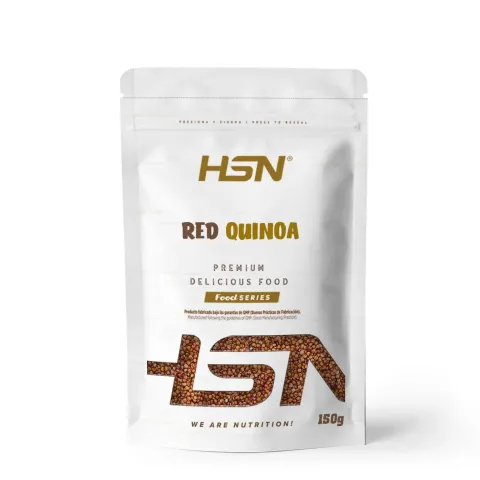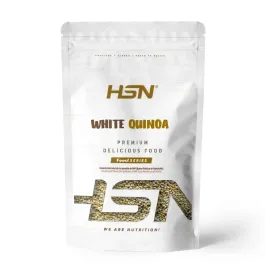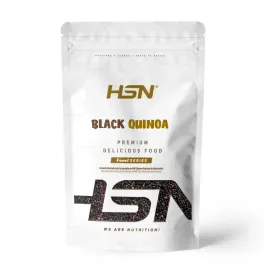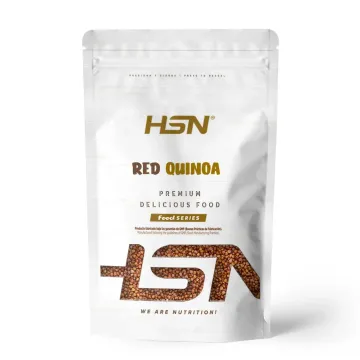- Discover quinoa - A pseudocereal used in international cuisine all around the world.
- Why is it so popular?: Quinoa is excellent – it's high in protein and fibre, and low in sugar.
- Suitable for coeliacs: Quinoa is not a gluten-containing cereal. Enjoy a gluten-free side dish.
- Only for the adventurous! Quinoa is a great alternative to rice or other side dishes. Go ahead and give it a try.
- Enjoy a variety with more bite, red quinoa is firm and perfect for recipes where you want to feel its texture.
Red quinoa – Ideal for salads and poke bowls
Red quinoa from FoodSeries is a natural HSN food product, with no added ingredients, made using the red variety of quinoa.
Quinoa is categorised as a pseudocereal because it's used like a cereal, but doesn't meet the criteria to be one. It's used in many culinary traditions across the globe and has become popular as part of a healthy lifestyle due to its excellent nutritional profile, rich in fibre, protein, and complex carbohydrates.
The red quinoa variety is firmer and has more bite compared to the more classic white variety.
Dare to try red quinoa and explore all its uses
Get to know quinoa and why it's so popular in cooking
Quinoa is a seed native to the Andes that has become a key global food thanks to its exceptional nutritional value. While not technically a cereal, it is considered a pseudocereal due to its composition and how it's consumed. It's a plant-based source of complete protein, naturally containing all essential amino acids, and is especially high in fibre. One of its main advantages over conventional cereals is that it doesn't contain gluten and has a low glycaemic index, making it a healthy and versatile option for many diets.
Quinoa is highly valued in cooking and has become a staple ingredient in many types of diets. Its protein content is significant and complete, which is rare among plant sources. It's also rich in fibre, an important nutrient whose intake has dropped with the rise of ultra-processed foods. Its complex carbohydrates provide sustained energy, ideal for athletes. Among its varieties, red quinoa stands out for its firmer texture and slightly nutty flavour, making it ideal for salads, sides, and dishes that require more consistency, as it holds its shape better after cooking.
Red quinoa is the most ‘balanced’ variety
Red quinoa is considered the most balanced of the three main types (white, red, and black), as it combines features of both. Its texture is firmer than white quinoa but less hard than black, making it ideal for those looking for a middle ground between softness and firmness when cooked. Its flavour is slightly more intense with a hint of nuttiness, making it tastier than white without being as earthy as black. It's also rich in protein and fibre, offering strong nutritional value, similar to other varieties.
In the kitchen, red quinoa stands out for its ability to maintain its shape after cooking, making it a great choice for salads, stir-fries, and hot or cold dishes where a firmer texture is desired. It offers a great balance of lightness and structure, making it more versatile than black quinoa, which can be harder, and more resilient than white, which tends to be softer. Thanks to these qualities, it's a popular choice for those seeking a middle ground in flavour, texture, and nutrition.
See for yourself in this comparison table:
| | White quinoa | Red quinoa | Black quinoa |
| Colour | Beige / Ivory | Reddish / Dark brown | Black |
| Flavour | Mild and neutral | Moderate | Strong |
| Texture | Soft and fluffy | Firm and crunchy | Very firm and hard |
| Cooking time | 10–15 min | 15–20 min | 20–25 min |
| Recommended use | All types of recipes | Salads and poke bowls | Vegan burgers and side dishes |
| Nutritional value | Good protein and fibre content | Higher fibre content | Similar to red |
Gluten-free – Quinoa is suitable for coeliacs
One of the biggest limitations of many cereals used in cooking, especially in the West, is the almost unavoidable presence of gluten in their composition, which, although not a problem for many, is an issue for coeliacs. Quinoa, which behaves like a cereal though it technically isn't, is naturally gluten-free.
At HSN we also process our products in our own facility, which is ISO certified for particle filtration in cleanrooms. This means that thanks to our controlled handling of raw materials not only is quinoa inherently gluten-free, but we also guarantee it is completely free from cross-contamination.
What does red quinoa taste like?
Red quinoa has a stronger, slightly nutty flavour compared to white quinoa, which makes it ideal for dishes where you want a more distinct taste. Its texture is also firmer, so it stands out more wherever you use it.
For example, if you're making a 'three-delight quinoa' dish where you want a very soft base, you might prefer white quinoa. But if you're preparing quinoa as a side for meat, or in a veggie stir-fry, you'll want more bite – and that's where red quinoa shines and becomes a unique variety. It also brings a vibrant colour to dishes, which along with its flavour, gives red quinoa a special character.
This variety is especially appreciated in high-end restaurants where chefs create innovative quinoa-based dishes looking for the perfect balance of texture and flavour.
Red quinoa in your diet – What does it offer?
Red quinoa contains:
- 15% protein: With a complete amino acid profile, the ideal side for your healthy lifestyle.
- 7% fibre: A more than significant amount, especially considering how difficult it is for people nowadays to reach recommended daily intake.
- 64% carbohydrates (1.5% sugars): Low in sugar while being a source of carbohydrates, meaning the carbs it provides are complex – ideal as part of a Mediterranean diet and as a base for your food pyramid.
What does ‘more bite’ mean?
As we've mentioned before, red quinoa is firmer, even after cooking, so if you're looking for a quinoa you can use in dishes where you want it to be more noticeable, where you can actually feel the quinoa seeds as you eat, then red is your best choice.
Why should you rinse quinoa?
Quinoa contains natural compounds called saponins, which can be easily removed with water.
These compounds are mainly on the outer layer, and although they are completely safe and have no nutritional or functional effect, they can taste bitter. Rinsing the quinoa removes them, leaving a much smoother flavour.
 Before
Before After
After During
During Morning
Morning Afternoon
Afternoon Night
Night Before
Before After
After During
During Morning
Morning Afternoon
Afternoon Night
Night Before
Before After
After During
During Morning
Morning Afternoon
Afternoon Night
Night















